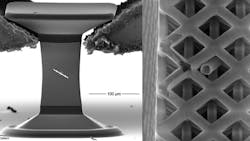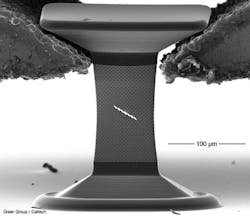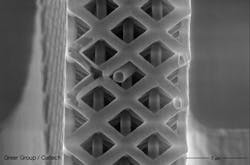New Materials Are Made of Nano- and Micro-scale Building Blocks
Engineers at the California Institute of Technology are creating new materials out of micro- and nano-scale building blocks that can be arranged into periodic or arbitrary structures. Described as “architected materials,” they sometimes exhibit unusual properties. For example, the team has made ceramics with foam-like recoverability, lightweight but ultra-strong frames that can bounce back after compression, and mechanically strong batteries.
The team determined that failures of architected materials—the point at which they break when compressed or stretched—can be described using classical continuum mechanics which models the behavior of a material as a continuous mass rather than as individual (or “discrete”) particles. This finding implies a dual nature for these materials in that they can be thought of as individual particles and as a single collective.
An architected material is strength-tested by stretching until failure. (Courtesy: Greer Group/Caltech)
Architected materials are interesting to engineers because of their often-unusual properties, but their behaviors are difficult to predict. It is impossible to know how they will respond to stress until they are created in a lab and tested. As such, creating these materials has been largely a matter of trial-and-error: Researchers dream up new lattice structures and then crush and stretch them to see how strong they were. Although this process has led to some interesting discoveries, predicting how a given lattice will perform under pressure before actually building it would let engineers more easily create purpose-built materials.
The team built a lattice of hollow, 50-nanometer-thick aluminum oxide beams, then placed the lattice under tension and recorded when and how it cracked. Tests showed the material’s strength-over-density ratio (specific strength) is four times higher than that of any other material.
Here’s a close-up look at one of the architected materials tested at Caltech. (Courtesy: Greer Group/Caltech)
The failure tests also let the team theorizer how architected materials fail in general. This new analysis is said to give engineers a way to design materials particularly resistant to damage and tearing while maintaining exceptionally low weight.
Understanding when and how a material fails is critical if it is to be useful in real-world applications, where it would never be pushed beyond the failure point. Such information lets designers create new materials that are lighter and stronger than any yet produced and will fail in simple, predictable ways. By contrast, many conventional (that is, non-architected) materials fail suddenly and in ways that can be difficult to foresee and describe.



